The Netgear 10-port 1GbE ULTRA60 POE++ switch is really interesting not necessarily just because of its networking capacity but because of its ability to power devices. Since that is a long product name, we are going to call this by the model number or the “Netgear GS710TUP.” We a few months ago we published our Key Differences of PoE vs PoE+ vs PoE++ Switches a STH Guide article. This Netgear switch is the first POE++ switch capable of delivering 480W across its eight PoE ports or 60W per port using PoE that we have tested. Let us get into the review.
Netgear GS710TUP Overview
Taking a look at the GS710TUP we can find a fairly substantial 1U switch. The unit itself measures 440 x 204 x 43mm or 17.3 x 8.0 x 1.7in which feels large for a 10-port 1GbE switch. This perception is supports as one lifts the unit out of the box. This is not a light unit with a weight of almost 3kg or almost 6.6lbs. For comparison, the Netgear GS110EMX weighs around 1.65lbs even with two 10Gbase-T Ethernet ports.
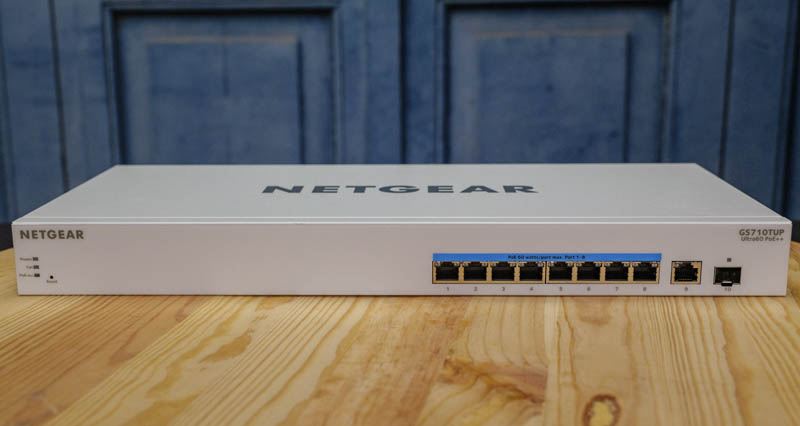
Getting into the main feature of the switch we have ten 1GbE ports. There are eight 1GbE ports that are the key feature as they have 60W Type-3 PoE++ delivery.
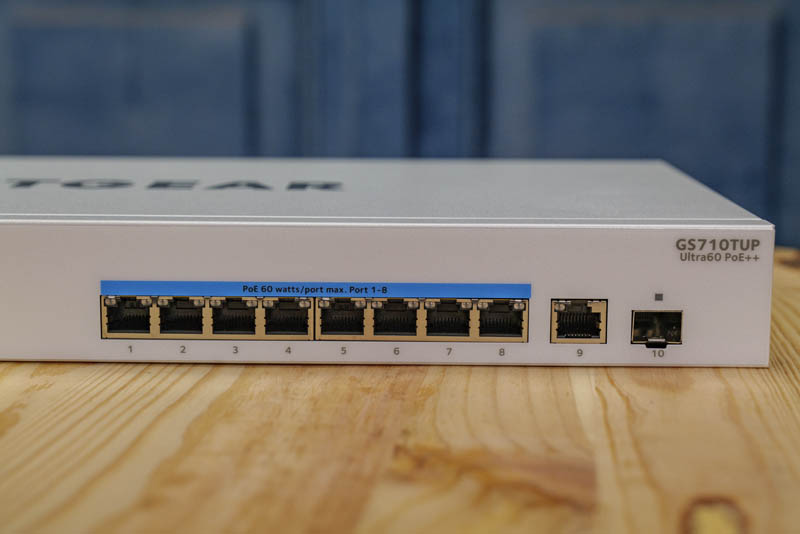
Ports 9 and 10 do not have PoE and are uplink ports. Unlike the GS110EMX, the uplink ports are only 1GbE as well. That means that there is a 4:1 oversubscription ratio between the PoE++ ports and the uplink ports. We would have preferred if these were 10GbE ports. Here we have a copper and a SFP port. With 10GbE ports we tend to prefer SFP+ ports then using SFP+ to 10Gbase-T Adapter Modules. With 1GbE ports, this is a lower-cost proposition.
The rear of the chassis has a Kensington lock port and then a lot of sheet metal. The main feature is really the AC input. One can see the text below this says 100-240V at 8A max.
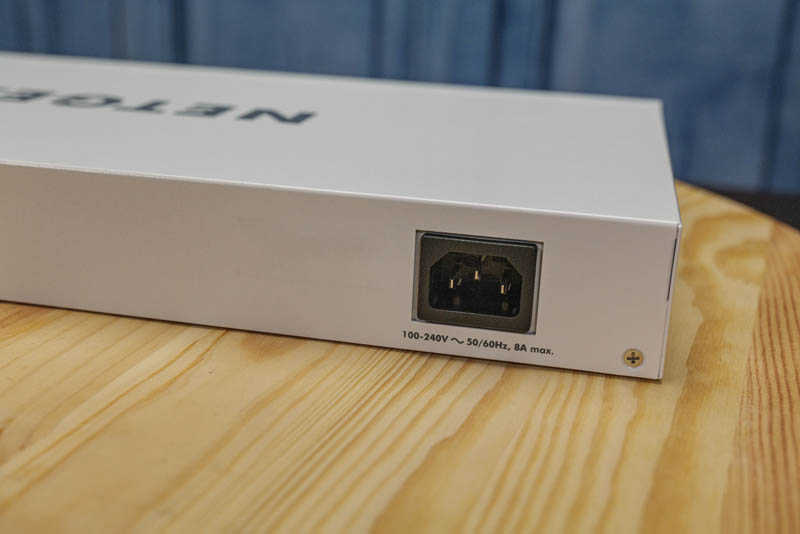
We normally do not discuss accessories, however, since the external view of the switch is so simple we wanted to briefly cover here. One can see rubber feet as well as standard rack ears. Netgear even provides mounting hardware (although we are mostly using CPI Clik-Nuts.) This is a nice touch. We are going to discuss the noise aspect in our power and noise testing later in this review which may impact your desire to use rubber feet versus mounting on rack ears for an equipment closet.
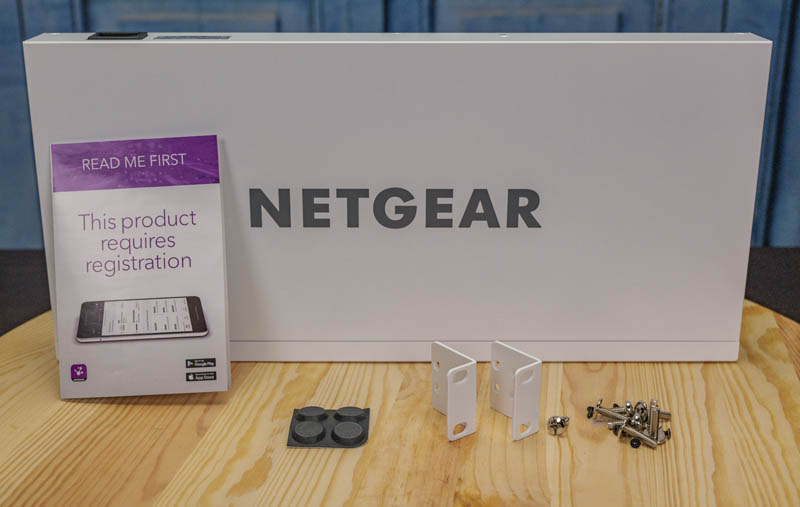
Inside the switch, we have a small switch PCB with a power supply that is near the side of the switch PCB itself. Then again, this is a 10x 1GbE switch on the networking side making it a relatively lower-end networking device. In a $415-499 switch, we would like to see 10GbE uplinks even if delivered via SFP+.
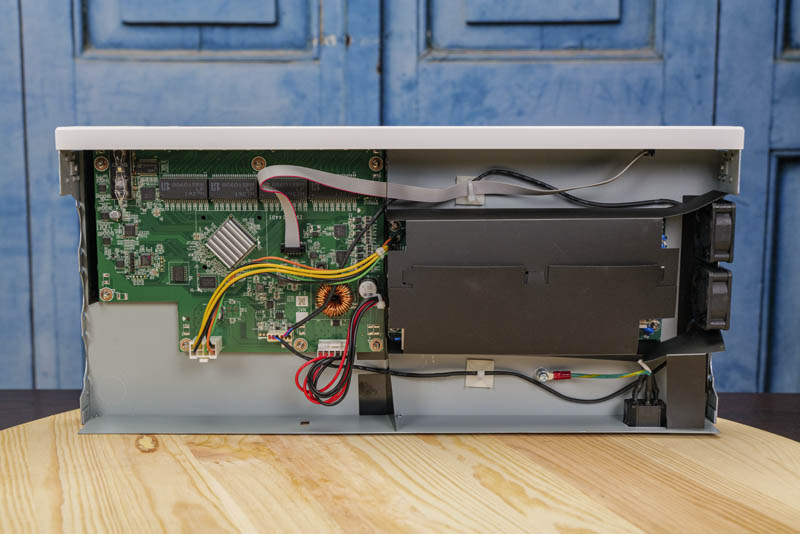
For the image above, we had to re-assemble the airflow guide over the PSU. This is what the airflow guide looked like the first time we opened the switch:
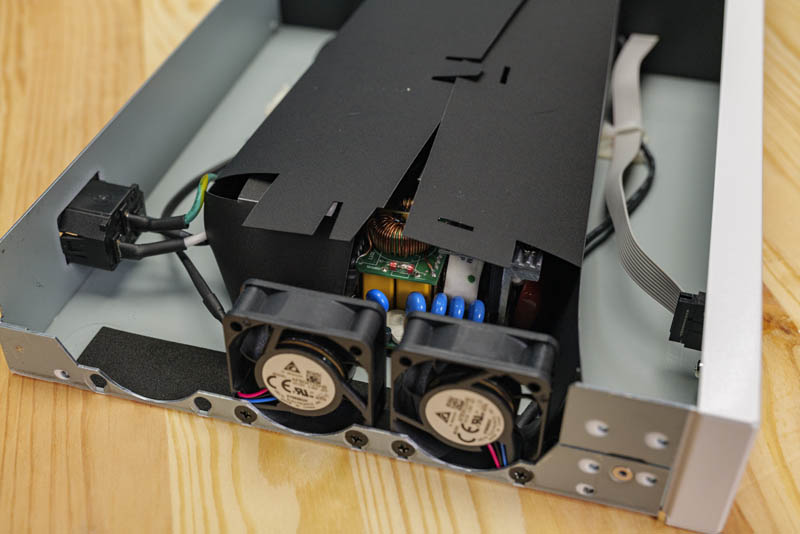
As one can see, there are two tabs that were not seated properly. Also, on the left side above towards the rear of the switch the airflow guide was blocking airflow to the power supply given its orientation. That may be the intended design, however, we seated all three tabs and opened this end of the airflow guide as shown in the Internal Overview picture before re-assembly since that seemed to make more sense. We did not notice a drop in noise levels from testing before this change so it may not have made a difference.
Opening this airflow guide up, we can see a 3Y Power Technology power supply which is also marked with FSP group. The model seems to be this one. Something notable here is that the PSU actually has an 80Plus Gold rating. While most servers in the 500-800W PSU range, even the Tyan Thunder SX GT90-B7113 we reviewed recently are 80Plus Platinum rated devices, the 80Plus Gold here is notable since we do not normally see these types of efficiency ratings on this class of network gear. Great job to Netgear for souring an efficient and large PSU for this switch.
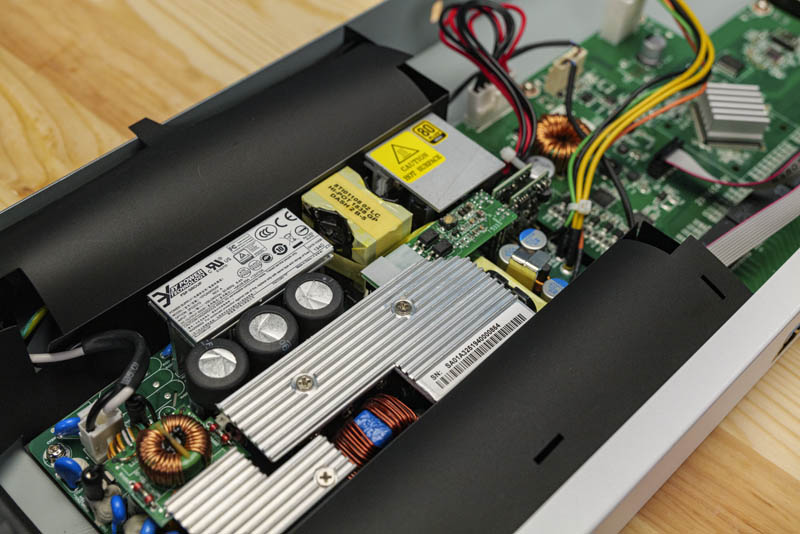
Since this is a 600W unit, it is able to cope with 8x 60W (480W) of PoE++ output. Many other PoE++ switches on the market offer less than the rated power if all ports are loaded while Netgear can deliver full power across the different ports. Beyond anything else with this switch, this power supply is the key differentiator.
Here is a quick look at the two fans. Each has a 3-pin power connection to the main switch PCB.
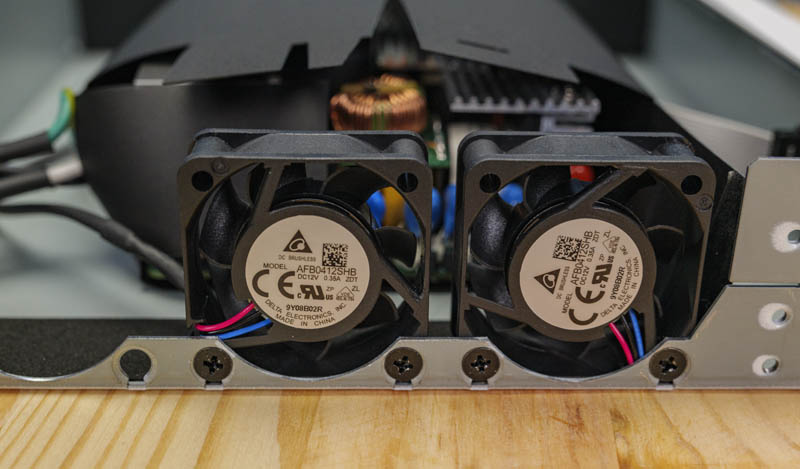
Here we can see the switch internals. The switch chip is very small and has a heatsink affixed to it. As you can see compared to the ultra-high-end switches we have seen, such as the Hands-on with the Intel Co-Packaged Optics and Silicon Photonics Switch this is a relatively simple layout.
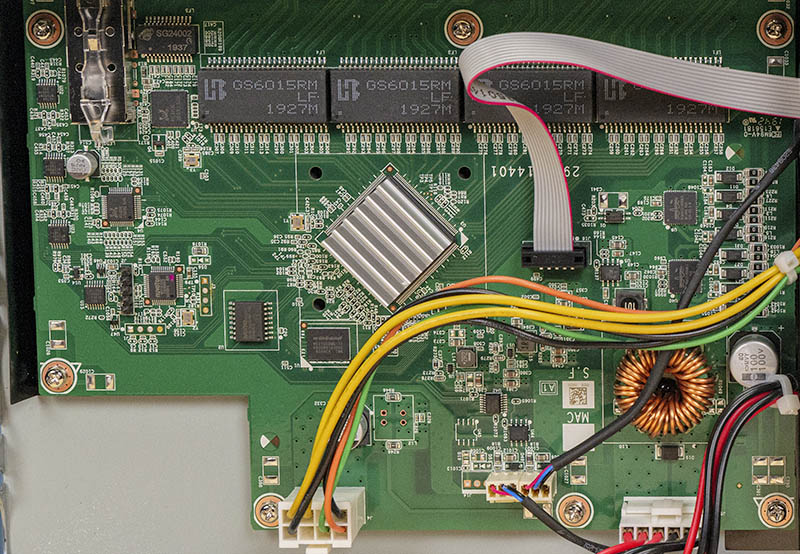
Also notable is that this PCB directly injects power. Many switches we see have secondary PCBs that add power but here we get the full power delivery all through a single part.
Next, we are going to take a look at management before getting to performance, power consumption, and noise.

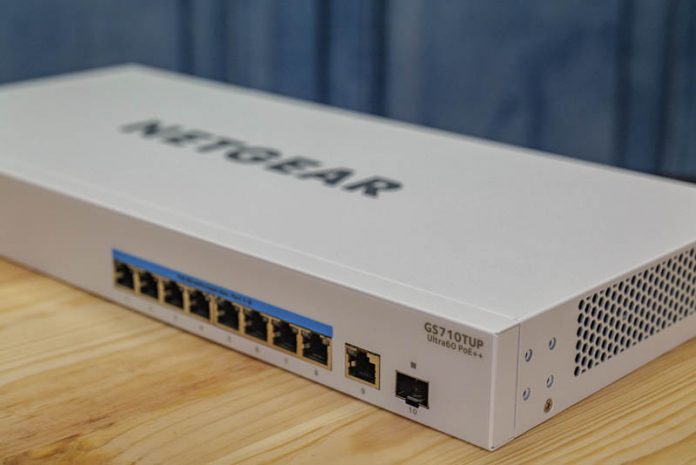



I do not understand these artificial limitations.
Why do I have to register a stupid switch this way to gain complete control over a purchased device?
LOL. Before we had switches from Cisco & other US companys, and likely other countries like China with backdoors who were silently implemented (https://en.wikipedia.org/wiki/Cisco_Systems#Firewall_backdoor_developed_by_NSA).
Now we are on the way to be forced into proprietary cloud access, giving away control and opening up a can of worms of major security implications. With or without backdoors manated by national security letters.
Open up your network and its security to Netgears cloud and even their crappy App… What can go wrong?
What a clever idea, at least for Netgear and the hunger for mass surveillance and potential control by the national security establishment.
/s
Sadly this seems to be the way the market leaders are headed. The potential gains for companys like Netgear are too tempting IMO.
Why did you rate the GS710TUP so highly in the score card. In the article, you indicate the value is not good, but you rated 9.2 on the score card. You indicate most users would not be happy paying the annual subscription. You mention that the license agreement to use the full management is not very friendly to the customer as it is has advertising and app data sharing. You mention that it only has mediocre performance.
Granting such a high overall score, you are encouraging netgear to continue with mediocre performance and licensing terms.
@Vicent 100% spot-on. I’ve commented similarly on another product review page, the scores don’t reflect reality, what I’ve seen is mediocre products given unwarranted scores..
Too bad it doesn’t have at least one 10G uplink. Also I’m curious about how long it will take before we get 2.5G as standard. Chipsets have been available since 2013, but the demand has simply not been there. I guess it is only this year that there is enough momentum thanks to 2.5G being common on the latest AMD B550/X570 and Intel B460/Z490 based motherboards. Does anybody know what is a normal timeframe from product development to time-to-market for switches? Can we expect a lot more 2.5G switches next year?
Really? I have to install a smartphone app to enable features on the switch?
Otherwise i only have a “trial version” of a switch, you say? Oh, what a bright and “smart” future lies ahead of us.
I never desired to turn into a grumpy old curmudgeon, but i have to admit finding myself rather liking to live in the past (technology-wise) than to deal with modern craptastic devices like this.
Yeah, and the score. What Vince said, very well put. It sorta gives me the vibes of those videogame magazines of yore (particularly the ones from the UK) with their inflated scores. But then again, i am not enthusiastic about smartphones and smartwatches, and generally am a grumpy curmudgeon who found himself preferring the simpler, less exploitative past (technology-wise), so i guess i am not really hip enough to judge the niner-score-deserving allure of this modern PoE network switch…
So after buying a few Netgear switches (1G+10G, a few PoE+) earlier this year and only recently installing them.. I discover this cloud BS. Seriously? If I update the firmware the switch management will be cloud only. I’m on the last firmware that has “local” login.
The thing is.. and I cannot stress this enough: GTFO!
I’m currently looking for a new network hardware vendor.
Which is a shame because Netgear were good.
I think the score is way off. There is no technical reason to limit the feature set, so this is obviously a strong anti-customer move to force registration and even use of their cloud service. Do they at least assume full liability should their cloud be breached?
@Nils
A related question: Do pigs fly? ;-)
I now have a Netgear switch that required this registration BS. My switch had the option of “local management” or “cloud management”. Of course I chose “local management” as I block all of my switches from outbound access to the Internet; I have internal NTP servers and manage everything on-site. What?! No phone apps to control anything. I know, how lame is that, but it’s fairly secure compared to “phone apps” and “cloud based” BS.
I had to jump through hoops to register the switch as there is a non-inuitive process to obtain the registration key by email for switches that cannot access the Internet. I don’t know the feature set different between “local management” and “cloud management”, but I agree with the article’s observation that the unregistered feature set is practically worthless. I was able to confirm through an arduous email exchange with Netgear Support (they must hire uneducated id10ts to work there) that the registration key is “lifetime”…or until you replace the switch with a Netgear replacement when the first one fails :))
fyi – Once you have registered your Netgear switch, take some time to carefully watch it’s network operation with a packet sniffer. As I said, I block all of my switches from accessing the Internet; that’s how I caught my newly registered switch trying to reach out to the Internet, specifically 2 different AWS locations in the EU are requested on a repetitive basis. Humm… what’s up with that? Will anyone from Netgear tell us since their own Support staff know how to “not answer” (personal experience here) requests for information.
My own impressions of Netgear are positive and built on 10+ years of using their products. never so much as a need to contact support or replace one of their “lifetime warranty” Prosafe switches. And now this registration BS. I guess Netgear isn’t making enough money from their actual products so now they are trying to get us to buy their faux (i.e. “cloud”) products as a way to supplement their revenue stream. Sadly, more and more network equipment vendors with reasonable (or better) quality products are moving in this direction. Let’s face it folks, it’s that “gotta be in the cloud to be cool” attitude that so pervasive in today’s world which is ruining it for the rest of us.
The review itself was pretty fair.
The score is not appropriate however and I would recommend removing or revisiting it. I really like the quality of your site (and have made purchases based off of reviews) and this score undermines all of that.
1) build quality leaves a lot to be desired.
2) lack of >1GbE is a no go if you are using this to power multiple 802.11ac APs. Why am I going to waste a lot of expensive PoE ports on LAGs?
3) select hiding of such basic features behind a paywall without being upfront about it like meraki is not cool. They are trying to copy the model enterprise model using a consumer pricing and retail privacy approach (lol at that privacy policy) which just comes off as disingenuous and cheap. Meraki (et al) are straight forward about all of nothing cloud-management but this is just straight up paywalling for are configured on-device.
A month ago I was weighing various vendors for a new access switch for one of my labs and stuff like this disqualified netgear.
please review the GSM4210P
also MS510TXUP